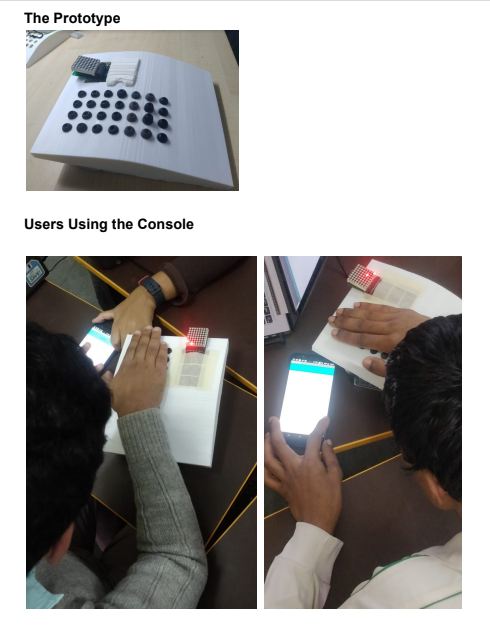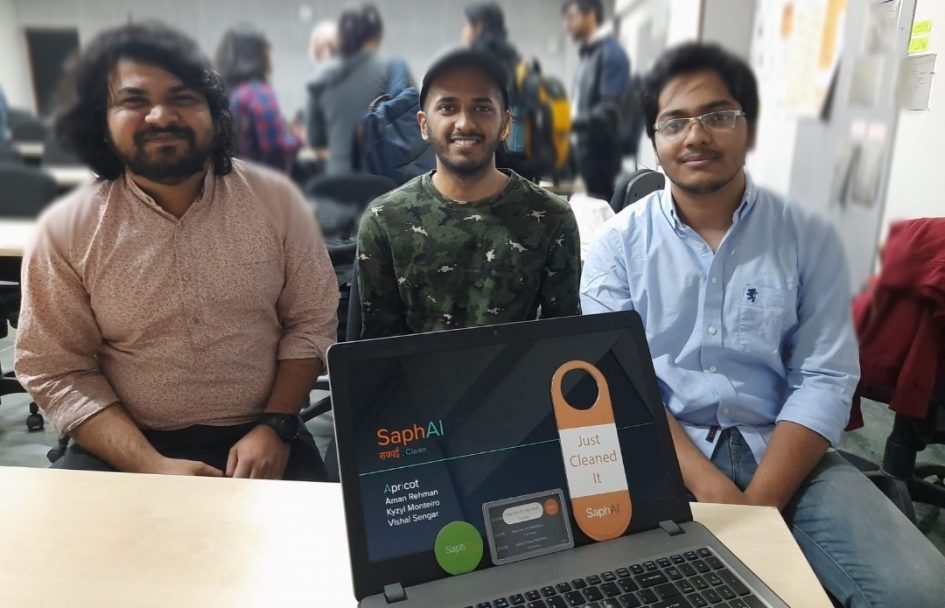At IIIT Delhi, we believe in giving our students opportunities beyond the regular classroom teachings through various Btech and Mtech programs including some very fascinating programs like Computer Science and Design, Computer Science and Artificial Intelligence etc. You can view the list of all programs here.
We offer an array of courses for the students to choose from. A great amount of time and effort is put in designing each and every course at our institute in a manner which not only makes our students academically strong, but also helps them to think out of the box to bring out the researcher in them.
To keep up with the latest trends in the world of technology we have introduced some very interesting courses in the curriculum like:
- Designing Human-Centered Systems course which is an introduction to designing, prototyping, and evaluating user interfaces. It focuses on how to design human-centered systems that people find useful and usable and is inspired by the course that Prof. Jason Hong teaches at CMU, Designing Human-Centered Systems.
- Artificial Intelligence, a name that has become an integral part of technology in our daily lives. With increase in usage, there is a significant requirement of researchers who can understand AI and build AI technologies. Through this course we introduce the students to various search techniques, knowledge representation, reasoning, and learning and enable them to utilize AI for application in real world.
- Advanced Internet of Things course delves deeper into some of the technologies pertinent to IoT and students will be exposed to some of the latest research findings in IoT.
- Game Development and Design is a hands-on project-based course which introduces students to the fundamentals of game development & design using the Unreal 4 game engine. Topics include level design, lighting, materials, particle effects, game AI, game logic, user input mappings, audio, physics and motion. Students will learn to implement custom game logic using the Blueprints Visual Scripting system.
Apart from these, we have many other courses that you can view here. As a part of their course curriculum, students have to submit projects based on the course they choose. Here are few impressive projects by our students:
AI solution for real-time monitoring and cleaning of interior space
Course: Human-Centered Artificial Intelligence
Instructor: Dr. Grace Eden (Assistant Professor, HCD)
Students: Aman Rehman, Kyzyl Monteiro & Vishal Singh Sengar
Our students from CSD department worked on an AI solution SaphAI that aims at shifting from a complete routine based cleaning system to a routine-cum-demand based cleaning system. This is done using Artificial Intelligence for monitoring the campus space for litter detection, weather analysis and analyzing staff schedules.
By analyzing a combination of these factors the system recommends rooms and areas for cleaning on priority and urgency levels. Consequently, they attempt to improve the efficiency and effectiveness of cleaning services and the experience for all stakeholders: the In-charge, cleaning staff members and the students. Three interfaces were built, one each for all the stakeholders.
A new device for cleaning staff members was prototyped which listed all the rooms and areas assigned to clean. Each item in the list shows the reason for the request. Cleaning staff members could also provide feedback for requests. This was made to separate personal and professional commitments since current mechanism uses staff’s phone for both purposes.
A mobile app for students was designed which enabled students to schedule room services as and when required. They could schedule services instantly or for a later time. It also enabled students to list the reason for request so that appropriate equipment could be arranged. Appropriate feedback for each service was also taken.
An interface for the In-charge was made which listed all the data required by them. This included monitoring of the entire campus, list of requests, staff schedules, automatic task assignment, etc. All the recommendations came with reasons. Improvement in the system comes from the response on the In-charge by accepting and/or rejecting recommendations made by the system.

The students tested their solutions with all the stakeholders and design was made to cater all of them. An end inclusion was a door hanger. This idea was inspired by the ‘Slippery floor’ board that is placed by the cleaning staff. This was added to be a subtle reminder to students to try and keep the rooms clean and respect the cleaning staff’s work more. However, this hasn’t been tested yet.
HungerDeal: Development of Mobile Application for the Comparison of Food Delivery Applications
Course: Design of Interactive Systems
Instructor: Rajiv Ratn Shah (Assistant Professor (CSE, HCD))
Students: Gaurav Gautam, Jatin Singhal, Kanupriya Singh and Shruti Dabas
The team worked on developing a system that enables easy and efficient comparison of prices for the selected dish over multiple food delivery applications. The need of such an app raised from the fact that the competition amongst food delivery apps is increasing with so many options to choose from. As a result of this, the service provided by these applications differs on a lot of parameters like cost, delivery time and restaurant available. Due to the difference in delivery charges, service charges, and packaging charges, the final price of products differs a lot, thus making it increasingly difficult for users to get the best price.
The aim of this study is to provide an app-based solution that compares the services of the same dish ordered from various food delivery applications and guides the user to order from the application that maximizes his savings and provides him/ her with the best services. User studies, contextual inquiries, and evaluation are carried out at every step of the design and development process to ensure that the product has human-centered design at its core.
Further, the objective of the application is to yield accurate prices so as to provide the user with a cherishing experience as the difference in prices is rather small, so giving an approximate range would make the result of the comparison redundant. Thus at the backend, Selenium web scraper is used to obtain real-time data i.e. food prices and delivery times for a particular dish selected in their application “HungerDeal”. Once the user clicks on the compare option, the Selenium scraper runs a data scraping script at the backend on the web portals of various food delivery applications like Swiggy, Zomato and UberEats, after which it provides the delivery time and total price of the food item. To further improve upon the speed, the system saves the results of the user’s previous compares in its database.
The design process for the application starts with the creation of low fidelity prototypes to get a basic essence of the layout for the application and get user feedback at initial stages. Paper prototypes are reiterated by incorporating user feedback. This process is repeated multiple times and digital high fidelity prototypes are created at a later stage which is then made into a functional prototype using Android Studio. The application underwent a series of the participant and expert-based evaluations which revealed that it reduces the time and effort the user has to put in to find food at the cheapest price.
Gaming Console for the Blind- A look into haptic HCI for gaming
Course: Design of Interactive Systems
Instructor: Rajiv Ratn Shah (Assistant Professor (CSE, HCD))
Students: Angel Walia, Mayank Jain, Prakhar Goel and Varnika Kairon
In modern society, there are various modes and techniques for entertaining people through games using technologies such as gaming consoles, massive multiplayer online games, mobile application games, etc. However, a key component of all these games is their ability to provide life-like visuals using excellent graphics quality. Now such an essential component of games proves to be useless when we delve into developing games for visually-impaired people. As such, there are only a few limited types of games available to them, most of which are non-tech based games. Our students wanted to explore the various ways in which visually impaired people can play games, more specifically give input and receive output other than just audio. They took to using haptics as a medium and implemented a gaming console primarily based on haptic feedback along with audio feedback.
The aim is to give visually impaired player a gaming experience which is more than just audio, as all current games targeted towards the visually impaired only use audio as the major output medium. The entire setup includes two components. (a) The Tactile Box or the Console itself and (b) The Android App
The Tactile Box is responsible for processing the game that is currently being played as well as the communication from the system to the user during the play period. It is also the component where if needed other people can witness the action that is taking place on small LED-Matrix that simulates the game environment.
The main communication between the system and the player, however, is achieved through a
7*4 (i.e. 7 rows and 4 columns) matrix made using Vibration Motors where each grid point is meant to simulate a pixel of the game that is being played. We have used an Arduino Mega microcontroller that runs the game and is responsible for the communication via the haptic grid and the LED grid.

The Android App is mainly responsible for the audio communication. It enables the communication between player and system using simple left or right swipes. It is also an essential component for the game to start, as well as responsible for the onboarding instruction. The students used Mit-AppInventor2 to develop the application and used the Text-To-Speech functionality for the onboarding process as well as reading the final score to the player.
The communication between the 2 components is achieved using a simple HC-05 Bluetooth.
In a very short span of time, IIIT Delhi
has created a name for itself in India and abroad for being a center of quality
education and research in IT and interdisciplinary areas and has established a
strong research culture, focused research groups, and innovative education
programs. These few of the many wonderful
projects by our students are an epitome of how IIIT Delhi has become one of the most promising young institutions for
education and research in India.
Stay tuned for more such work by our students!

Leave a Reply